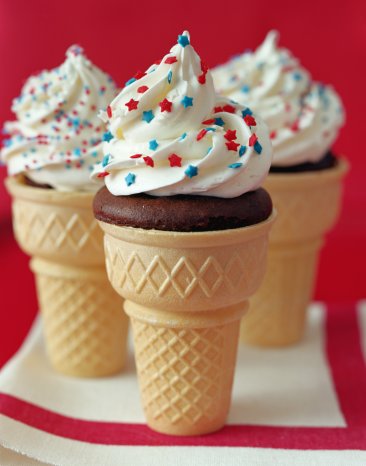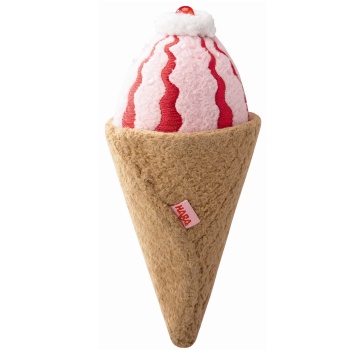
ICE
CREAM
THE WHOLE SCOOP
ON THE ICE CREAM
Can you remember the last time you had a dish of really good ice cream? What you are about to
read may help you make the decision to give up ice cream. There’s a good chance that that
“banana ice cream” in your freezer is flavored not with something that grows on trees, but with something that was invented in a test tube;
that its main ingredient is not milk, but air, and that its manufacturer may not even be legally entitled to label the cold glop called “ice cream” anyway.
Because ice cream is one of the foods for which the government has established “Standard of Identity,” manufacturers have to tell the Food and Drug Administration what they put
in their products, but they don’t have to tell you. That doesn’t mean, however, that you can’t consume your per capita quota of more than four gallons of gelid goodness this year without eating a lot of amyl acetate. (Laboratories use it to make ersatz banana extract) along with it.
Ice cream that has natural flavoring probably won’t be touted as such on the label. It simply will be called “vanilla ice cream.” If a
manufacturer uses natural flavors but injects some polysyllabic synthetics, he is supposed to inject the word “flavored” somewhere on
the label. The companies who use little or non of the real materials are obliged to call their products “artificial” or artificially flavored.” As usual the qualifiers are in relatively small print.
WHAT’S IN ICE CREAM?
Instead of just the traditional sweet cream and sweet milk that is suppose to go into the ice cream, the optimal dairy ingredients, as
amended in 1964, now include ice cream, dried cream, plastic cream, (sometimes known as concentrated milk fat), butter, butter oil, milk, concentrated milk, evaporated milk, dried milk, skim milk,
concentrated skim milk, evaporated skim milk, condensed skim milk, sweetened condensed skim milk, sweetened condensed
part-skim milk, nonfat dry milk sweet cream buttermilk, condensed sweet cream butter
milk, dried sweet cream buttermilk, skim milk that has been concentrated and from which part of the lactose has been removed by crystallization, skim milk in concentrated dried form that has been modified by treating
the concentrated skim milk with calcium hydroxide and disodium phosphage, concentrated cheese whey, and dried cheese whey.
A whole range of additives has gradually entered the scene, including antioxidants, neutralizers, butters, bacteriacides, stabilizers, and emulsifiers. Formerly eggs, milk protein,
fat lecithin, and other substances like gelatin, agar agar, or seaweeds were used as emulsifiers and stabilizers, but these have been replaced gradually with cheaper ingredients by many manufacturers.
Below is just a small example of what can be added to ice cream:
Piperonal is used in place of vanilla.
This chemical is used to treat lice. (Results in central nervous system depression.)
Diethyl glucol, a cheap chemical, is used as an emulsifier instead of eggs. Diethyl glucol is
the same chemical use in antifreeze and in paint removers.
Butyraldehyde is used in nut flavored ice cream. It is one of the ingredients in rubber cement.
(An irritant and narcotic.)
Amyl Acetate is used for its banana flavor. It’s also used as an oil paint solvent. (Results in headaches, fatigue, and irritates mucous membranes.)
Ethyl Acetate is used to give ice cream a pineapple flavor. It is also used as a cleaner for leather and textiles. (Its vapors have been known to result in chronic lung, liver and heart damage.)
Aldehyde C17 is used to flavor cherry ice cream. It is an inflammable liquid which is used in aniline dyes, plastic , and rubber.
AIRING IT OUT!
Ice cream is a whipped concoction of milk, cream, sugar and chemicals, and it is the whipping that determines its texture. In the whip-freeze machine, the basic mixture has plain air beaten into it to just the right consistency, usually expanding it volume 40-60%. Too much air, and the end product is course and crumbly: too little, and it can be thick and gummy.
The Food And Drug Administration has set no standards on the proportion of air that ice cream may contain(they do insist that it weigh 4.5 per gallon) and, business being business, some manufacturers will sell you all the air you want to buy at ice cream prices.
DID YOU KNOW
Ice cream, being a dairy product and perishable, sometimes perishes in your grocers storeroom or on a loading dock. Do they throw it out? Of course not! Did you know it is shipped back to the manufacturer? If it is a light enough flavor to be hidden, it is dumped into a new batch of heavily flavored chocolate ice cream that will reappear shortly in your supermarket. If the flavoring is artificial, the taste of any spoiled or otherwise unusable ingredients will be masked with such things as n-butyl phenyl, propylene glycol and ethylacetal. Plus, sugar in ice cream can hide a multitude of sins.
While manufacturers are required to give you at least a hint about the origin of their products’ flavor, they need breathe nary a word about its color. Nor are they obliged to mention the numerous stabilizers that are used to enhance the texture and melting characteristics of ice cream with too much air.
“DESIGNER” ICE CREAM
One of the greatest merchandising successes of the decade has been “designer” ice cream laced with crumbled candy or cookies. The market leaders are vanilla flavors mixed with Oreo cookie pieces or health bar chips. The makers have found a new demand for their products while also finding a convenient means of disposal for cookies and candy bars broken on the assembly line. These combinations pack a powerful caloric wallop. Even without the candy or cookies, designer ice cream, which are dense and contain more butterfat than the usual supermarket variety, have about 300 calories per one-cup serving. Add to that the empty calories of half a health bar or cookies and you bring the total up to about 375.
GIVING UP ICE CREAM
This is the difficult one for most people. The best choice to make is to divorce yourself from the temptress.
Obviouasly, commercial ice cream is not fit for human consumption. How about the “all-natural” ice cream or the homemade variety? They are objectionable for the same reasons that milk is objectionable and the refined sugar that is used to sweeten it. Even though some of the so-called “natural” ice cream may not contain some of the twenty to thirty additives, they still contain milk and cream, which in themselves can contain additives to the dairy cows. And sugar is about as bad (or perhaps almost as bad) as the chemical emulsifiers and preservatives. For optimal health it is best to eschew all ice cream.
“THE NATURAL” ICE CREAM
If you want a real treat make your own “natural” ice cream from just frozen bananas and other fruit.
Banana “ice cream”—is made by freezing bananas and putting them through a Champion juicer (using the homogenizing blank)—and is the best “substitute” for ice cream. It is as thick and “creamy” as ice cream.
For other flavors of “ice cream” add frozen fruits and top of with fresh chopped nuts or carob sauce. M-m-m-m Good!
Whether therefore ye eat, or drink, or whatsoever ye do, do all to the glory of God.
1 Corinthians 10:31
Katy Chamberlin
freedomofhealth.com
